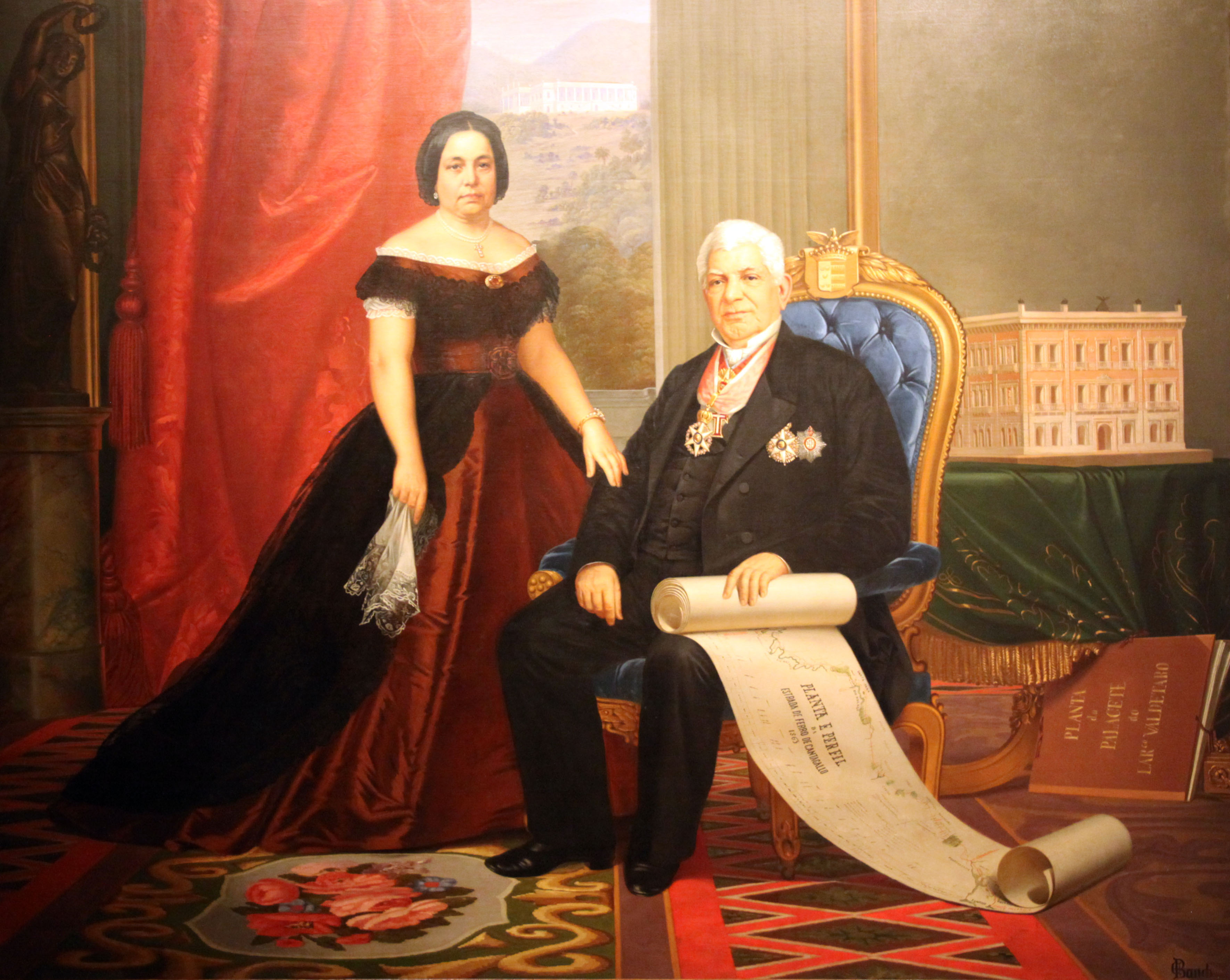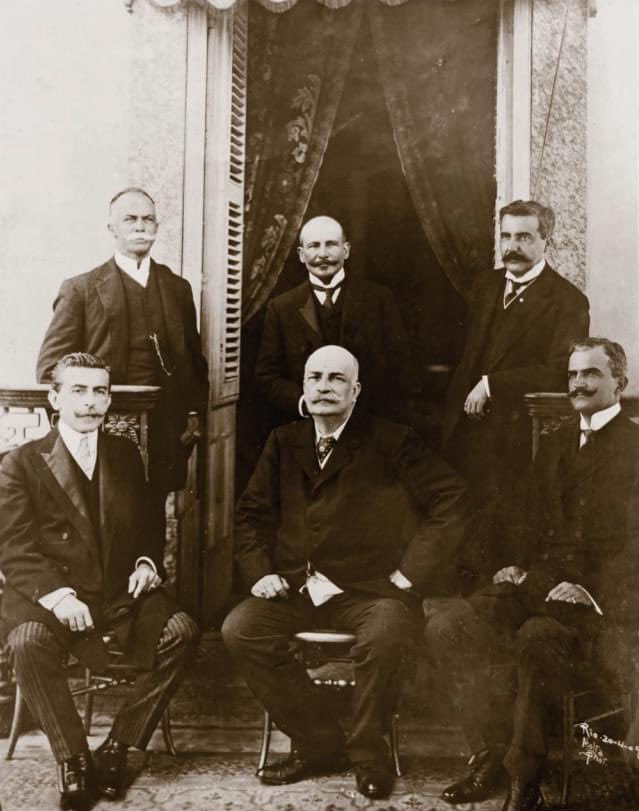|
Catete Palace
The Catete Palace ( pt, Palácio do Catete, ) is an urban mansion in Rio de Janeiro's Flamengo neighborhood. The property stretches from ''Rua do Catete'' (Catete Street) to ''Praia do Flamengo'' ( Flamengo Beach). Construction began in 1858 and ended in 1867. From 1897 to 1960, it was Brazil's presidential palace and the site of Getúlio Vargas' suicide. It now houses the ''Museu da República'' (Republic Museum) and a theatre. The Catete underground rail station is adjacent. History The building was built as the residence of family of the Portuguese-born Brazilian coffee producer António Clemente Pinto, Baron of Nova Friburgo, in the then capital of the Empire of Brazil. It was called the Palace of Largo Valdetaro and Palace of Nova Friburgo. With the design of German architect Carl Friedrich Gustav Waehneldt, dated 1858, the work began with the demolition of the old house. The construction officially ended in 1866, but the finishing works still continued for over a decade. ... [...More Info...] [...Related Items...] OR: [Wikipedia] [Google] [Baidu] |
Neoclassical Architecture
Neoclassical architecture is an architectural style produced by the Neoclassical movement that began in the mid-18th century in Italy and France. It became one of the most prominent architectural styles in the Western world. The prevailing styles of architecture in most of Europe for the previous two centuries, Renaissance architecture and Baroque architecture, already represented partial revivals of the Classical architecture of ancient Rome and (much less) ancient Greek architecture, but the Neoclassical movement aimed to strip away the excesses of Late Baroque and return to a purer and more authentic classical style, adapted to modern purposes. The development of archaeology and published accurate records of surviving classical buildings was crucial in the emergence of Neoclassical architecture. In many countries, there was an initial wave essentially drawing on Roman architecture, followed, from about the start of the 19th century, by a second wave of Greek Revival architec ... [...More Info...] [...Related Items...] OR: [Wikipedia] [Google] [Baidu] |
Afonso Pena
Afonso Augusto Moreira Pena (; 30 November 1847 – 14 June 1909) was a Brazilian politician who served as the List of presidents of Brazil, sixth president of Brazil between 1906 and 1909. Before his political career, Pena had been an attorney and legal scholar. He was the first president of Brazil to die in office. Pena began his political career in 1874 with an election to the Imperial General Assembly. In the succeeding years, Pena reconciled legislative work with some periods occupying secretariats—secretary of Agriculture (1882), Commerce and Public Affairs (1883) and Justice (1885). As president of the provincial assembly of Minas Gerais, Pena inaugurated the new capital Belo Horizonte. After the Proclamation of the Republic (Brazil), proclamation of the Republic, he was List of governors of Minas Gerais, president of Minas Gerais between 1892 and 1894. It was during his administration that Belo Horizonte was set for the future state capital (which at that time was Ouro ... [...More Info...] [...Related Items...] OR: [Wikipedia] [Google] [Baidu] |
Theatres In Rio De Janeiro (city)
Theatre or theater is a collaborative form of performing art that uses live performers, usually actors or actresses, to present the experience of a real or imagined event before a live audience in a specific place, often a stage. The performers may communicate this experience to the audience through combinations of gesture, speech, song, music, and dance. Elements of art, such as painted scenery and stagecraft such as lighting are used to enhance the physicality, presence and immediacy of the experience. The specific place of the performance is also named by the word "theatre" as derived from the Ancient Greek θέατρον (théatron, "a place for viewing"), itself from θεάομαι (theáomai, "to see", "to watch", "to observe"). Modern Western theatre comes, in large measure, from the theatre of ancient Greece, from which it borrows technical terminology, classification into genres, and many of its themes, stock characters, and plot elements. Theatre artist Patric ... [...More Info...] [...Related Items...] OR: [Wikipedia] [Google] [Baidu] |
Museums In Rio De Janeiro (city)
A museum ( ; plural museums or, rarely, musea) is a building or institution that Preservation (library and archival science), cares for and displays a collection (artwork), collection of artifacts and other objects of artistic, culture, cultural, history, historical, or science, scientific importance. Many public museums make these items available for public viewing through display case, exhibits that may be permanent or temporary. The largest museums are located in major cities throughout the world, while thousands of local museums exist in smaller cities, towns, and rural areas. Museums have varying aims, ranging from the conservation and documentation of their collection, serving researchers and specialists, to catering to the general public. The goal of serving researchers is not only scientific, but intended to serve the general public. There are many types of museums, including art museums, natural history museums, science museums, war museums, and children's museums. Ac ... [...More Info...] [...Related Items...] OR: [Wikipedia] [Google] [Baidu] |
Palaces In Rio De Janeiro (city)
A palace is a grand residence, especially a royal residence, or the home of a head of state or some other high-ranking dignitary, such as a bishop or archbishop. The word is derived from the Latin name palātium, for Palatine Hill in Rome which housed the Imperial residences. Most European languages have a version of the term (''palais'', ''palazzo'', ''palacio'', etc.), and many use it for a wider range of buildings than English. In many parts of Europe, the equivalent term is also applied to large private houses in cities, especially of the aristocracy; often the term for a large country house is different. Many historic palaces are now put to other uses such as parliaments, museums, hotels, or office buildings. The word is also sometimes used to describe a lavishly ornate building used for public entertainment or exhibitions such as a movie palace. A palace is distinguished from a castle while the latter clearly is fortified or has the style of a fortification, whereas a pa ... [...More Info...] [...Related Items...] OR: [Wikipedia] [Google] [Baidu] |
Presidential Palaces In Brazil
President most commonly refers to: *President (corporate title) *President (education), a leader of a college or university *President (government title) President may also refer to: Automobiles * Nissan President, a 1966–2010 Japanese full-size sedan * Studebaker President, a 1926–1942 American full-size sedan * VinFast President, a 2020–present Vietnamese mid-size SUV Film and television *''Præsidenten'', a 1919 Danish silent film directed by Carl Theodor Dreyer * ''The President'' (1928 film), a German silent drama * ''President'' (1937 film), an Indian film * ''The President'' (1961 film) * ''The Presidents'' (film), a 2005 documentary * ''The President'' (2014 film) * ''The President'' (South Korean TV series), a 2010 South Korean television series * ''The President'' (Palestinian TV series), a 2013 Palestinian reality television show *''The President Show'', a 2017 Comedy Central political satirical parody sitcom Music *The Presidents (American soul band) *The P ... [...More Info...] [...Related Items...] OR: [Wikipedia] [Google] [Baidu] |
Palácio Da Alvorada
The Palácio da Alvorada () is the official residence of the President of Brazil. It is located in the national capital of Brasília, on a peninsula at the margins of Paranoá Lake. The building was designed by Oscar Niemeyer and built between 1957 and 1958 in the modernist style. It has been the residence of every Brazilian president since Juscelino Kubitschek. The building is listed as a National Historic Heritage Site. IPHAN. Retrieved on 2013-03-27. . While it is used as a residence and for reception, the president's official workplace, and center of the executive branch, is the . Naming conventions The building was initially refe ...[...More Info...] [...Related Items...] OR: [Wikipedia] [Google] [Baidu] |
Palácio Do Planalto
The Palácio do Planalto () in Brasília is the official workplace of the president of Brazil.Palácio do Planalto Presidency of Brazil. Retrieved on 2009-07-19. . The building was designed by architect in 1958 and inaugurated on April 21, 1960. It has been the workplace of every Brazilian president since . It is located at the |
Catetinho
The Catetinho was the first official workplace of the President of Brazil Juscelino Kubitschek. History The name ''Catetinho'' comes from the then official residence of the president, the Catete Palace. Oscar Niemeyer's project, was built in just 10 days, in November 1956. It is a simple building, made of wood, and known as "''Palácio de Tábuas"'' ("''Planks Palace")''. It was planned without comfort or official honours, so that the President didn't distance himself from the workers, who lived in shacks and tents. See also * List of Oscar Niemeyer works List of buildings and structures by Brazilian architect Oscar Niemeyer. From the approximately 600 projects designed by Niemeyer, only the most notable are listed below. Early works (1930s) *1936 – Gustavo Capanema Palace, Ministry of Educatio ... References External links {{DEFAULTSORT:Catetinho Palaces in Brasília Presidential palaces in Brazil Oscar Niemeyer buildings Tourist attractions in Brasília [...More Info...] [...Related Items...] OR: [Wikipedia] [Google] [Baidu] |
Muses
In ancient Greek religion and mythology, the Muses ( grc, Μοῦσαι, Moûsai, el, Μούσες, Múses) are the inspirational goddesses of literature, science, and the arts. They were considered the source of the knowledge embodied in the poetry, lyric songs, and myths that were related orally for centuries in ancient Greek culture. Melete, Aoede, and Mneme are the original Boeotian Muses, and Calliope, Clio, Erato, Euterpe, Melpomene, Polyhymnia, Terpsichore, Thalia, and Urania are the nine Olympian Muses. In modern figurative usage, a Muse may be a source of artistic inspiration. Etymology The word ''Muses'' ( grc, Μοῦσαι, Moûsai) perhaps came from the o-grade of the Proto-Indo-European root (the basic meaning of which is 'put in mind' in verb formations with transitive function and 'have in mind' in those with intransitive function), or from root ('to tower, mountain') since all the most important cult-centres of the Muses were on mountains or hills. R ... [...More Info...] [...Related Items...] OR: [Wikipedia] [Google] [Baidu] |
World War II
World War II or the Second World War, often abbreviated as WWII or WW2, was a world war that lasted from 1939 to 1945. It involved the vast majority of the world's countries—including all of the great powers—forming two opposing military alliances: the Allies and the Axis powers. World War II was a total war that directly involved more than 100 million personnel from more than 30 countries. The major participants in the war threw their entire economic, industrial, and scientific capabilities behind the war effort, blurring the distinction between civilian and military resources. Aircraft played a major role in the conflict, enabling the strategic bombing of population centres and deploying the only two nuclear weapons ever used in war. World War II was by far the deadliest conflict in human history; it resulted in 70 to 85 million fatalities, mostly among civilians. Tens of millions died due to genocides (including the Holocaust), starvation, ma ... [...More Info...] [...Related Items...] OR: [Wikipedia] [Google] [Baidu] |
Axis Powers
The Axis powers, ; it, Potenze dell'Asse ; ja, 枢軸国 ''Sūjikukoku'', group=nb originally called the Rome–Berlin Axis, was a military coalition that initiated World War II and fought against the Allies. Its principal members were Nazi Germany, the Kingdom of Italy, and the Empire of Japan. The Axis were united in their opposition to the Allies, but otherwise lacked comparable coordination and ideological cohesion. The Axis grew out of successive diplomatic efforts by Germany, Italy, and Japan to secure their own specific expansionist interests in the mid-1930s. The first step was the protocol signed by Germany and Italy in October 1936, after which Italian leader Benito Mussolini declared that all other European countries would thereafter rotate on the Rome–Berlin axis, thus creating the term "Axis". The following November saw the ratification of the Anti-Comintern Pact, an anti-communist treaty between Germany and Japan; Italy joined the Pact in 1937, follow ... [...More Info...] [...Related Items...] OR: [Wikipedia] [Google] [Baidu] |

_-_facade_on_Piazza_dei_signori.jpg)




.jpg)


